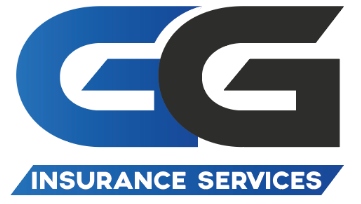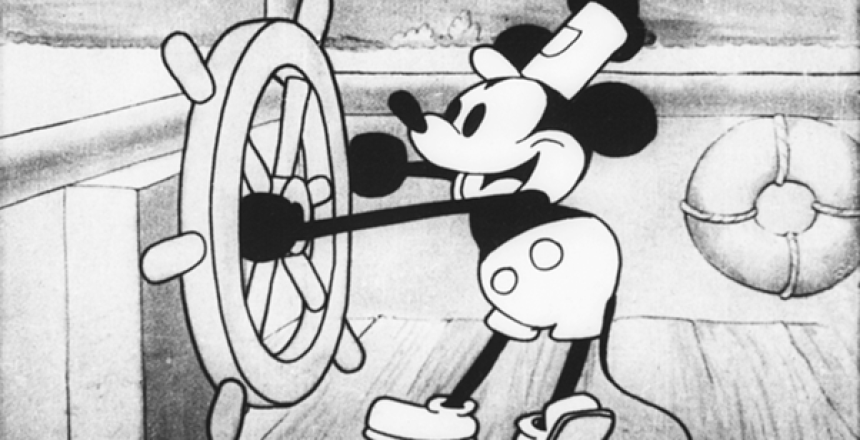This article will break down the situation with Mickey Mouse and explain how the Copyright Term Extension Act (aka The Mickey Mouse Protection Act) works, as more things will be set to enter the public domain and it is important to understand the nuances…
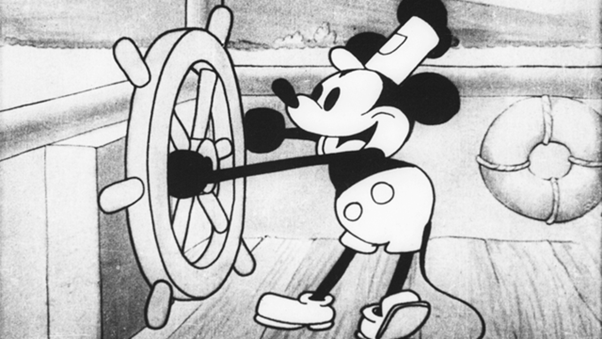
(Image Credit: The Walt Disney Company)
So, what’s happened to Mickey?
Mickey Mouse has entered the public domain on 1st January 2024, 95 years after his appearance in Steamboat Willie in 1928.
U.S. copyright law allows copyrights to last for 95 years. Since Mickey Mouse first appeared in the famous animated film “Steamboat Willie” in 1928, the characters from this classic animation became part of the public domain starting January 1, 2024.
Despite most news reports focusing on Mickey, it is also worth noting that Minnie Mouse has also entered the public domain, as she also features in the 1928 cartoon;
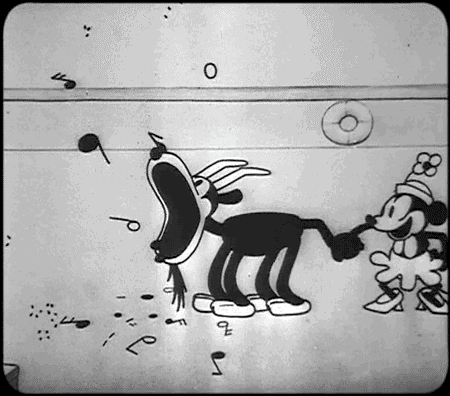
Source: https://commons.m.wikimedia.org
What does “Public Domain” mean?
When something becomes public domain, it means that it is no longer under the protection of copyright, patent, or trademark laws, and therefore, can be used freely by anyone without obtaining permission from its original creator or paying royalties. This allows the public to freely access, use, and build upon these works without legal restrictions.
But it is not quite as simple as using Mickey Mouse however we want, as it is only the original version of Mickey that featured in Steamboat Willie that has entered the public domain, later versions are still protected, plus Disney has an ongoing trademark.
Mickey’s Origins
We all know and recognise Mickey Mouse, and that the character was created by Walt Disney and has been the mascot of The Walt Disney Corporation for many years following his debut in Steamboat Willie on November 18, 1928.
Mickey Mouse was created as a replacement for Oswald the Lucky Rabbit, an earlier cartoon character that was created by the Disney studio, but owned at the time by Universal Pictures.
Universal took control of Oswald’s character in 1928, leading Disney to create a new character as a replacement, Mickey Mouse…
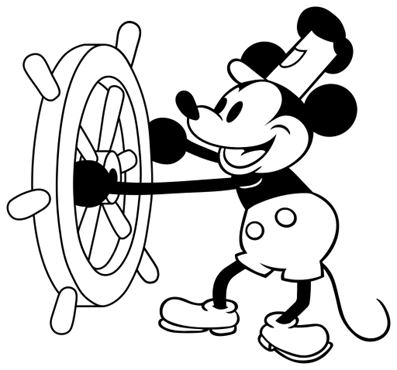
Source: https://en.wikipedia.org
Interesting Video-Game-Related Sidenote on Oswald;

Source: https://epicmickey.fandom.com/wiki/Oswald_the_Lucky_Rabbit
In 2003, Buena Vista Games pitched a concept for an Oswald-themed video game to then-Disney President and future-CEO Bob Iger, who became committed to acquiring the rights to Oswald. In 2006, The Walt Disney Company successfully acquired the trademark of Oswald, bringing him back to the House of Mouse with Disney’s 2010 video game
Oswald returned in Disney’s 2010 video game, Epic Mickey.
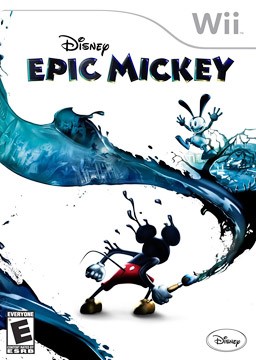
Image Source: https://en.wikipedia.org
A brief explanation of copyright and how it works:
Copyright is a legal concept that grants creators of original works exclusive rights to copy and publish their creations for a certain period of time.
Copyright is automatically granted to the creator as soon as the work is created (some jurisdictions require that this be fixed in a tangible form that is perceptible either directly or with the aid of a machine or device).
This means that as soon as you draw a character, write a story, compose a song, take a photograph, or create a painting, you automatically have copyright protection for that work.
It is important to highlight here that while this is “automatically” granted, if you want to have meaningful protection you also will need to prove you created the work (and when).
How to protect your own copyright
(source: https://copyrightservice.co.uk/protect )
If you discover that someone else is using your copyrighted material, or someone accuses you of using theirs, you will need to defend your case as the rightful owner. Here are some tips on how to do that…
Ensure your work is properly marked (use the © symbol)

A correctly worded notice will deter infringement, as it states that the work is protected under law.
Although a copyright notice is not required, (work is automatically subject to copyright protection under law), displaying a notice shows that you have an awareness of copyright and take infringements of your work seriously. It also helps to deter infringement (particularly from those who do not understand copyright) if you make it clear that your work is protected under copyright law.
Register your work
If your work is infringed and your claim to copyright is disputed (i.e. in a plagiarism case – where the other party claims the work is theirs), you may need evidence to help prove your claim.
There are various services around the world where you can formally register your claim, which once registered should greatly assist you with defending you as the original creator.
Keep or register supporting evidence.
Supporting evidence falls into two categories:
- Evolution of ideas
This is evidence of the progression of the work. Early drafts, synopsis, rough recordings, sketches, etc. are all evidence that the work progressed over time, rather than being copied from elsewhere. Although it is possible to fake such evidence, it is often time consuming to do so, so it can be fairly good evidence to demonstrate that you created the work from scratch over a period of time.
- Footprints or watermarking
This is normally evidence inserted into finished documents that will identify the author in some way, such as deliberate mistakes, or hidden data or code that can be read using special applications.
Agreement between co-authors.
If your work is a joint venture, be sure you know exactly where you stand, who will own what rights, and what happens when someone leaves.
Talk to a lawyer if you need extra help.
There are some excellent lawyers that specialise in the games industry who can assist with making sure that your copyright is sufficiently protected.
What’s the difference between Copyright and a Trademark and a Patent?
The concepts of patents, trademarks, and copyrights are distinct forms of intellectual property protection, each serving a different purpose:
- Copyright: As mentioned earlier, copyright protects original works of authorship, such as books, music, films, paintings, software, and photographs. Copyright protects the expression of ideas but not the ideas themselves, facts, or systems.
- Patent: A patent is a form of protection granted to inventors, giving them the exclusive right to make, use, sell, and import an invention for a limited period, typically 20 years from the filing date of the patent application. Patents are granted for new, useful, and non-obvious inventions, which can be products, processes, or designs. To obtain a patent, inventors must disclose detailed information about their invention, which becomes public information. Patents require a formal application process, including an examination for compliance with legal criteria.
- Trademark: A trademark is a symbol, word, or phrase legally registered or established by use as representing a company or product. Trademarks protect brand names, logos, slogans, and other identifiers that distinguish goods or services. The key purpose of a trademark is to prevent consumer confusion by distinguishing the source of goods or services.
Trademarks do not expire as long as they are in use and continue to be distinctive. However, they must be actively used and defended to maintain exclusive rights, and in many jurisdictions, they need to be renewed periodically.
In summary:
- Copyright protects artistic and literary works.
- Patents protect inventions and innovations.
- Trademarks protect brand identities and consumer recognition.
How did Disney lose their copyright to Mickey Mouse?
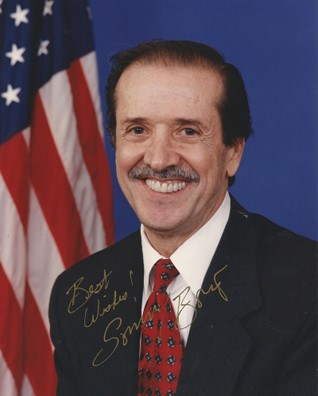
Image Source: https://en.wikipedia.org
The Copyright Term Extension Act, aka The Mickey Mouse Protection Act:
The Sonny Bono Copyright Term Extension Act – also known as the Copyright Term Extension Act, Sonny Bono Act, or (derisively) the Mickey Mouse Protection Act extended copyright terms in the United States in 1998.
It is one of several acts extending the terms of copyright. The act was named in memory of the late Congressman Sonny Bono, who died nine months before the act became law: he had previously been one of twelve sponsors of a similar bill.
Since 1990, The Walt Disney Company had lobbied for copyright extension. The legislation delayed the entry into the public domain of the earliest Mickey Mouse cartoons, leading detractors to the nickname “The Mickey Mouse Protection Act”.
Opponents also argue that the Act encourages “offshore production,” in which derivative works could be created outside the United States in areas where copyright would have expired, but US law would prohibit these works from being shown to US residents. For example, a cartoon of Mickey Mouse playing with a computer could be legally created in Russia, but the cartoon would be refused admission for importation by US Customs due to infringing US copyrights
Mickey Mouse, has been rigorously defended by Disney for many years. Originally, the copyright for Disney’s 1928 animation “Steamboat Willie” fell under the Copyright Act of 1909 which at the time allowed for works to be copyrighted for a period of 28 years from the date of publication and renewed for a further 28 years to a maximum of 56 years.
Steamboat Willie was therefore set to expire in 1984. However, it was Disney who advocated for a change in U.S. copyright laws, resulting in an extension to “the life of the author plus 50 years,” thereby extending the protection for “Steamboat Willie” until 2003.
In 1998, Disney, in collaboration with other entertainment companies including Universal, further influenced the extension of copyright terms. This time, the protection was extended to “the life of the author plus 70 years,” or 95 years after the work’s publication, whichever comes first. This legislative change extended the copyright for “Steamboat Willie” until the end of 2023, and this amendment was derisively referred to as the Mickey Mouse Protection Act.
So, can we use Mickey or not?
- You cannot use Mickey in a way that misleads consumers into thinking your work is affiliated with, sponsored, or endorsed by Disney, as Mickey is still trademarked.
- You also cannot use newer versions of Mickey, until those copyrights expire.
If you want to use Mickey or Minnie, you must be very careful on how they are depicted, and that any new works are clearly derived from the original 1928, and do not include elements of later (still protected) works.
In the original “Steamboat Willie” animation, Mickey Mouse is depicted with a sharper nose, a longer tail, no pupils, and he does not speak. However, the more familiar versions of Mickey, characterized by large eyes and red shorts, are still under copyright protection. These versions are expected to gradually enter the public domain in future decades.
Mickey Mouse is also a registered trademark owned by Disney, which can be renewed perpetually. This trademark allows Disney to exert some control over how the character is used. For example, in the film “Winnie-the-Pooh: Blood and Honey,” the character Pooh is not shown wearing a red shirt, a specific look that Disney has trademarked.
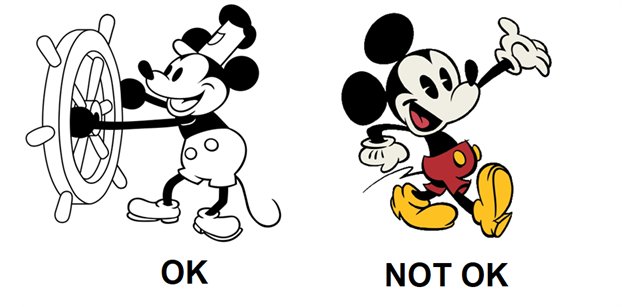
Does this apply worldwide?
Anyone in the US can make use of Steamboat Willie to create new stories and artwork. But as copyright protections vary from country to country, Steamboat Willie will remain protected in some jurisdictions. Steamboat Willie’s co-creator Ub Iwerks passed away in 1971 potentially extending protection in some jurisdictions until 2042.
Some studios have already taken advantage of this with Fumi Games’ upcoming shooter MOUSE
Description: MOUSE boasts a unique visual style inspired by the charm of 1930s rubber hose animation, transporting players to a nostalgic era of early cartoons. Assume the role of a private detective navigating a noir city teeming with gangs, mobs, and characters from the dark side. Unravel a quest for justice in a noir city mired in chaos, corruption, and vibrant energy, utilizing a diverse arsenal of weapons, power-ups, and explosives to thwart the takeover by corrupt politicians. The game’s playful weaponry and distinctive health display, coupled with enemies behaving like cartoon characters, add a lighthearted twist to traditional FPS gameplay.
The real question to consider, is it really worth it?
Disney can be expected to be monitoring any uses of Mickey closely (as they already do for all their intellectual property), and it is crucial to understand that while you may feel confident that your use of Mickey is ok, that Disney could disagree and still attempt to block or sue you.
You would then have to defend yourself against their legal team, and even if you “win” you will not necessarily get your legal costs back.
Before making any moves, consider consulting with a good lawyer, and having a good insurance policy is also a great safety net.
There is insurance available for copyright infringement for these kinds of situations, to cover the legal costs of defending your business against accusations. If you would like to learn more get in contact with us.
However, such coverage generally is for unintentional and unintended breaches. Most insurers would be unwilling to cover depictions of characters that are still very much under scrutiny, unless you can demonstrate you have actively sought advice from a lawyer and taken all necessary steps to ensure you are compliant. If you would like to learn more about available coverage, please do get in touch.
So, what is next on the horizon for release:
2024
The House at Pooh Corner by A. A. Milne, including the character Tigger, enters the public domain in 2024.
Notable films which entered the public domain in the United States include
Buster Keaton‘s The Cameraman,
Harold Lloyd‘s final silent feature Speedy.
Additional notable works which entered the public domain in the United States include
Lady Chatterley’s Lover by D. H. Lawrence,
Orlando: A Biography by Virginia Woolf,
The Well of Loneliness by Radclyffe Hall,
Millions of Cats by Wanda Gág,
Decline and Fall by Evelyn Waugh,
The Mystery of the Blue Train by Agatha Christie,
Story of the Eye by Georges Bataille,
The Threepenny Opera by Bertolt Brecht,
An American in Paris by George Gershwin.
2025
Among the films that will enter public domain in 2025 are;
the first film of The Marx Brothers, The Cocoanuts,
The Broadway Melody, Buster Keaton’s Spite Marriage,
Harold Lloyd’s first sound film Welcome Danger,
On with the Show!, the first sound film in color
The Taming of the Shrew, the first Shakespeare film-adaptation with
Hallelujah which is the first Hollywood film with an all black cast,
The Cock-Eyed World, Show Boat containing some songs of the 1927 musical,
Alfred Hitchcock‘s first sound film Blackmail,
Atlantic which is the first sound film about the Titanic-disaster,
G.W. Pabst‘s Pandora’s Box and Diary of a Lost Girl both starring Louise Brooks,
Documentary film Drifters,
Luis Bunuel and Salvador Dali‘s film Un Chien Andalou,
Man Ray‘s film The Mysteries of the Chateau of Dice, and Joris Ivens‘ Rain,
the sound versions of the Mickey Mouse-cartoons Plane Crazy and The Gallopin’ Gaucho, and the first Silly Symphony cartoons, including The Skeleton Dance.
Examples of important literary works entering the public domain include
Ernest Hemingway‘s novel A Farewell to Arms,
Ellery Queen‘s detective novel The Roman Hat Mystery,
Margery Allingham detective novel The Crime at Black Dudley,
the first English translation of Erich Maria Remarque’s novel All Quiet on the Western Front,
Alfred Döblin’s novel Berlin Alexanderplatz in its original German,
Bibhutibhushan Bandyopadhyay’s novel Pather Panchali in its original Bengali,
Lynd Ward‘s graphic novel Gods’ Man,
William Faulkner‘s novel The Sound and the Fury,
Virginia Woolf‘s essay A Room of One’s Own,
Ludwig Wittgenstein’s essay Some Remarks on Logical Form
and the first part of the 14th edition of Encyclopædia Britannica.
Important artworks entering the public domain include
René Magritte‘s painting The Treachery of Images,
Salvador Dali‘s painting The Great Masturbator

Coming in 2025…
GG Insurance Services
GG Insurance Services possesses a thorough understanding of the unique challenges and risks present in the video game industry. They bring this expertise to the table by providing a variety of specialized insurance solutions specifically tailored to meet the changing demands of game developers. By choosing to work with GG Insurance, game developers not only have access to innovative insurance options but also receive expert guidance that can be crucial in navigating situations like contract disputes or legal liability issues.Beyond merely offering insurance solutions, GG Insurance demonstrates a deep commitment to the growth and sustainability of the video game industry. They actively engage with their clients, fostering robust relationships and providing supportive advice. This commitment is evident in their proactive strategies, their expansive network, and their active involvement in the industry.
